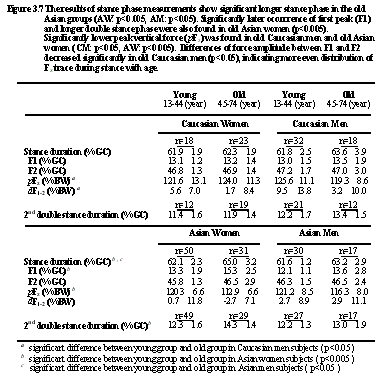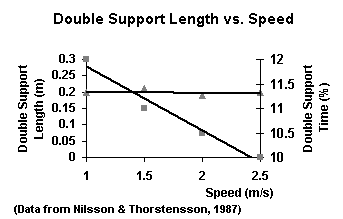
Probably like many of you out there, I usually start off my teaching
about gait with the normal
cycle. I have always asserted that normal stance duration is about
62%, yet it just occurred to
me that this is probably wrong.
In our own paper, back in 1985*, Mike Whittle and I reported the following regression equations:
Stance Duration = -3.5*speed + 64.2% (corr. 0.71)
Stance Duration = -6.7*stride length + 69.4% (corr. 0.74)
For normal speed and stride lengths of 1.5 m/s and 1.5 m both these
equations predict a stance
duration of 59%, which is, I think roughly correct. If any of you have
any data I'd be very
interested to know if you agree with me.
My question, then, is where did this figure of 62% come from? Isn't it time we rounded it off to 60%?
mailto:[n/a] as usual with your comments.
Chris
Dr. Chris Kirtley MD PhD
Associate Professor
Dept. of Biomedical Engineering
Catholic University of America
620 Michigan Ave NE, Washington, DC 20064
*Kirtley C, Whittle MW & Jefferson RJ (1985), Influence of Walking
Speed on Gait Parameters.,
Journal of Biomedical Engineering 7(4): 282-8.

Wen-ling Chen, D.Phil. P.T.
Department of Physical Therapy
National Cheng Kung University
Taiwan
male(n=21):
height:172.8(4.5)cm
stance duration: 61.5(1.9) %
stride length:1.36(0.11) m
speed:1.26(0.12) m/s
female(n=7):
height:160.5(2.4)cm
stance duration: 60.9(2.5) %
stride length:1.23(0.11) m
speed:1.16(0.12) m/s
Best Regards
Arash
Arash Salarian
Swiss Federal Institute of Technology-Lausanne (EPFL)
Laboratory of Movement Analysis and Measurement
STI - Institute for Biomedical Engineering
Bat - ELG
CH-1015 Lausanne
Tel: +41-21-693-5627 Fax: +41-21-693-2614

In normal walking the product of speed and double support time is
about constant at 20 cm (their Fig 4c). As a % of stride time it
decreases from 12% to 5% at 3(!) m/s (their Fig 3c) . So 12% is not
far off for normal speeds, but there is certainly a dependence of
speed.
Interestingly, Nilsson and Thorstensson made their subjects not
only walk/run at their self-chosen pace, but also at the fastest/
slowest cadence they could manage.
At Hof
Institute of Human Movement Sciences &
Laboratory of Human Movement Analysis AZG
University of Groningen
A. Deusinglaan 1, room 321
postal address:
PO Box 196
NL-9700 AD GRONINGEN
THE NETHERLANDS
Tel: (31) 50 363 2645
Fax: (31) 50 363 3150
http://www.ppsw.rug.nl/~ibw/